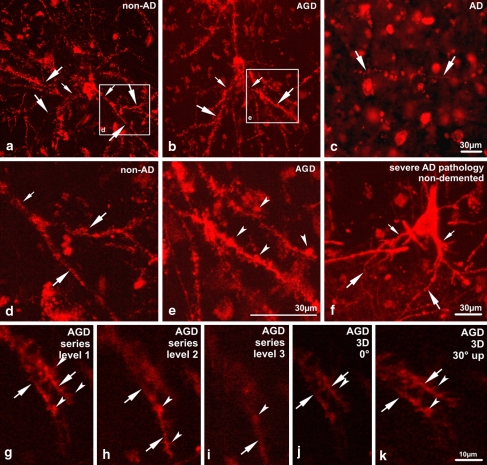Fig. 3.
Degeneration of dendrites in traced temporal layer III pyramidal neurons of area 35 of the temporal cortex. To analyze the integrity and structure of the dendrites stacks of ten images obtained by confocal laser scan microscopy in ∼10 μm distance were superimposed in a Z-project or analyzed in a 3D-project using the image J software. a Z-project. The pyramidal neurons of the non-demented control case (case No. 2) showed a symmetric dendritic tree with branching basal dendrites. The distal branches (large arrows) were smaller than the proximal ones (small arrows). The boxed area in a is enlarged in d. At high power magnification, only small spine-like structures were seen (arrows in d). b Z-project. The cognitively impaired AGD case (case No. 3) showed neurons with thin proximal basal dendrites (small arrows). The distal dendrites often appeared to have a similar or larger diameter (large arrows). High power laser-scan microscopy (boxed areae, enlarged in e) revealed prominent clumsy spines on the basal dendrites (arrowheads in e). c Fluorescence microscopy. The AD case No. 6 did not show labeling of neurons. Only few single neurites (arrows) were traced in the entorhinal cortex near the tracer application site indicating severe degeneration of the local neuronal network. f Z-Project. A surviving association neuron in the temporal neocortex of the non-demented case with severe AD-related pathology (case No. 7) showed basal dendrites without clumsy spines in a pattern similar to non-AD cases with mild AD-related pathology a, d. The proximal dendrites (small arrows) were thicker than the distal ones (large arrows). g–i Confocal images at three different levels indicate that there is no obvious dendritic beading (arrows in g–i). Three dimensional reconstruction presented in two different perspectives confirming the absence of dendritic beading (arrows in j, k). Clumsy dendritic spines were identified (arrowheads in g–i) and confirmed by 3D reconstruction (arrowheads in j, k). Calibration barc valid for a–c; e valid for d and e; and k valid for g–k

